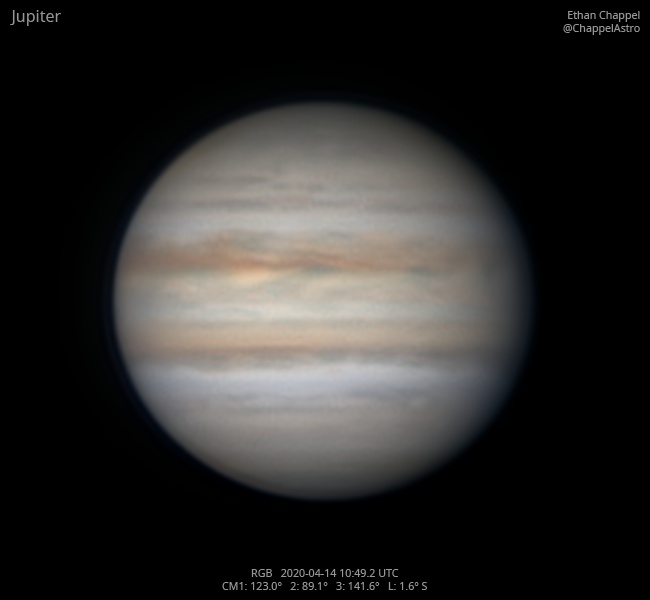

Jupiter UTC
CM1: 123.00°
CM2: 89.10°
CM3: 141.60°
CLat: -1.60°
Description
Although the morning was cold and windy, it has been two months since my last image of Jupiter, so I was going to be happy with whatever image I got. In order to catch all three bright morning planets before sunrise, I used my ASI224MC to capture all color channels at once.
Notes:
- The North Equatorial Belt seems to be widening.
- The Equatorial Zone is still slightly orange.
Equipment
ZWO ASI224MC
Celestron 2x
Celestron EdgeHD 8
Logs
FireCapture v2.6 Settings ------------------------------------ Observer=Ethan Chappel Camera=ZWO ASI224MC Filter=RGB Profile=Jupiter Diameter=38.55" Magnitude=-2.23 CMI=118.7° CMII=84.9° CMIII=137.3° (during mid of capture) FocalLength=5450mm (F/15) Resolution=0.14" Filename=2020-04-14-1043_1-EC-RGB.ser Date=2020_04_14 Start=10_42_26.917 Mid=10_43_11.921 End=10_43_56.925 Start(UT)=10_42_26.917 Mid(UT)=10_43_11.921 End(UT)=10_43_56.925 Duration=90.008s Date_format=yyyy_MM_dd Time_format=HH_mm_ss LT=UT -6h Frames captured=5757 File type=SER Binning=no Bit depth=8bit Debayer=yes DebayerAlgorithm=NearestNeighbor BayerPattern=RG ROI=436x422 ROI(Offset)=0x0 FPS (avg.)=63 Shutter=10.00ms Gain=350 (58%) AutoExposure=off AutoGain=off Brightness=1 (off) WBlue=99 (off) SoftwareGain=10 (off) Gamma=50 (off) AutoHisto=75 (off) USBTraffic=100 (off) HardwareBin=off HighSpeed=off FPS=100 (off) WRed=62 (off) Histogramm(min)=0 Histogramm(max)=149 Histogramm=58% Noise(avg.deviation)=0.84 AutoAlign=false PreFilter=none Limit=90 Seconds Sensor temperature=16.3°C FireCapture v2.6 Settings ------------------------------------ Observer=Ethan Chappel Camera=ZWO ASI224MC Filter=RGB Profile=Jupiter Diameter=38.55" Magnitude=-2.23 CMI=119.7° CMII=85.8° CMIII=138.2° (during mid of capture) FocalLength=5450mm (F/15) Resolution=0.14" Filename=2020-04-14-1044_7-EC-RGB.ser Date=2020_04_14 Start=10_44_00.828 Mid=10_44_45.833 End=10_45_30.838 Start(UT)=10_44_00.828 Mid(UT)=10_44_45.833 End(UT)=10_45_30.838 Duration=90.010s Date_format=yyyy_MM_dd Time_format=HH_mm_ss LT=UT -6h Frames captured=5757 File type=SER Binning=no Bit depth=8bit Debayer=yes DebayerAlgorithm=NearestNeighbor BayerPattern=RG ROI=436x422 ROI(Offset)=0x0 FPS (avg.)=63 Shutter=10.00ms Gain=350 (58%) AutoExposure=off AutoGain=off Brightness=1 (off) WBlue=99 (off) SoftwareGain=10 (off) Gamma=50 (off) AutoHisto=75 (off) USBTraffic=100 (off) HardwareBin=off HighSpeed=off FPS=100 (off) WRed=62 (off) Histogramm(min)=0 Histogramm(max)=157 Histogramm=61% Noise(avg.deviation)=0.85 AutoAlign=false PreFilter=none Limit=90 Seconds Sensor temperature=16.3°C FireCapture v2.6 Settings ------------------------------------ Observer=Ethan Chappel Camera=ZWO ASI224MC Filter=RGB Profile=Jupiter Diameter=38.55" Magnitude=-2.23 CMI=120.7° CMII=86.8° CMIII=139.3° (during mid of capture) FocalLength=5500mm (F/15) Resolution=0.14" Filename=2020-04-14-1046_4-EC-RGB.ser Date=2020_04_14 Start=10_45_40.386 Mid=10_46_25.392 End=10_47_10.399 Start(UT)=10_45_40.386 Mid(UT)=10_46_25.392 End(UT)=10_47_10.399 Duration=90.013s Date_format=yyyy_MM_dd Time_format=HH_mm_ss LT=UT -6h Frames captured=5757 File type=SER Binning=no Bit depth=8bit Debayer=yes DebayerAlgorithm=NearestNeighbor BayerPattern=RG ROI=436x422 ROI(Offset)=0x0 FPS (avg.)=63 Shutter=10.00ms Gain=350 (58%) AutoExposure=off AutoGain=off Brightness=1 (off) WBlue=99 (off) SoftwareGain=10 (off) Gamma=50 (off) AutoHisto=75 (off) USBTraffic=100 (off) HardwareBin=off HighSpeed=off FPS=100 (off) WRed=62 (off) Histogramm(min)=0 Histogramm(max)=148 Histogramm=58% Noise(avg.deviation)=0.84 AutoAlign=false PreFilter=none Limit=90 Seconds Sensor temperature=16.2°C FireCapture v2.6 Settings ------------------------------------ Observer=Ethan Chappel Camera=ZWO ASI224MC Filter=RGB Profile=Jupiter Diameter=38.55" Magnitude=-2.23 CMI=121.8° CMII=87.9° CMIII=140.4° (during mid of capture) FocalLength=5500mm (F/15) Resolution=0.14" Filename=2020-04-14-1048_2-EC-RGB.ser Date=2020_04_14 Start=10_47_29.978 Mid=10_48_14.980 End=10_48_59.982 Start(UT)=10_47_29.978 Mid(UT)=10_48_14.980 End(UT)=10_48_59.982 Duration=90.004s Date_format=yyyy_MM_dd Time_format=HH_mm_ss LT=UT -6h Frames captured=5756 File type=SER Binning=no Bit depth=8bit Debayer=yes DebayerAlgorithm=NearestNeighbor BayerPattern=RG ROI=436x422 ROI(Offset)=0x0 FPS (avg.)=63 Shutter=10.00ms Gain=350 (58%) AutoExposure=off AutoGain=off Brightness=1 (off) WBlue=99 (off) SoftwareGain=10 (off) Gamma=50 (off) AutoHisto=75 (off) USBTraffic=100 (off) HardwareBin=off HighSpeed=off FPS=100 (off) WRed=62 (off) Histogramm(min)=0 Histogramm(max)=158 Histogramm=61% Noise(avg.deviation)=0.87 AutoAlign=false PreFilter=none Limit=90 Seconds Sensor temperature=16.1°C FireCapture v2.6 Settings ------------------------------------ Observer=Ethan Chappel Camera=ZWO ASI224MC Filter=RGB Profile=Jupiter Diameter=38.55" Magnitude=-2.23 CMI=122.9° CMII=89.0° CMIII=141.5° (during mid of capture) FocalLength=5450mm (F/15) Resolution=0.14" Filename=2020-04-14-1050_0-EC-RGB.ser Date=2020_04_14 Start=10_49_19.543 Mid=10_50_04.545 End=10_50_49.548 Start(UT)=10_49_19.543 Mid(UT)=10_50_04.545 End(UT)=10_50_49.548 Duration=90.005s Date_format=yyyy_MM_dd Time_format=HH_mm_ss LT=UT -6h Frames captured=5756 File type=SER Binning=no Bit depth=8bit Debayer=yes DebayerAlgorithm=NearestNeighbor BayerPattern=RG ROI=436x422 ROI(Offset)=0x0 FPS (avg.)=63 Shutter=10.00ms Gain=350 (58%) AutoExposure=off AutoGain=off Brightness=1 (off) WBlue=99 (off) SoftwareGain=10 (off) Gamma=50 (off) AutoHisto=75 (off) USBTraffic=100 (off) HardwareBin=off HighSpeed=off FPS=100 (off) WRed=62 (off) Histogramm(min)=0 Histogramm(max)=150 Histogramm=58% Noise(avg.deviation)=0.90 AutoAlign=false PreFilter=none Limit=90 Seconds Sensor temperature=16.1°C FireCapture v2.6 Settings ------------------------------------ Observer=Ethan Chappel Camera=ZWO ASI224MC Filter=RGB Profile=Jupiter Diameter=38.55" Magnitude=-2.23 CMI=124.0° CMII=90.1° CMIII=142.6° (during mid of capture) FocalLength=5450mm (F/15) Resolution=0.14" Filename=2020-04-14-1051_8-EC-RGB.ser Date=2020_04_14 Start=10_51_08.307 Mid=10_51_53.312 End=10_52_38.317 Start(UT)=10_51_08.307 Mid(UT)=10_51_53.312 End(UT)=10_52_38.317 Duration=90.010s Date_format=yyyy_MM_dd Time_format=HH_mm_ss LT=UT -6h Frames captured=5757 File type=SER Binning=no Bit depth=8bit Debayer=yes DebayerAlgorithm=NearestNeighbor BayerPattern=RG ROI=436x422 ROI(Offset)=0x0 FPS (avg.)=63 Shutter=10.00ms Gain=350 (58%) AutoExposure=off AutoGain=off Brightness=1 (off) WBlue=99 (off) SoftwareGain=10 (off) Gamma=50 (off) AutoHisto=75 (off) USBTraffic=100 (off) HardwareBin=off HighSpeed=off FPS=100 (off) WRed=62 (off) Histogramm(min)=0 Histogramm(max)=152 Histogramm=59% Noise(avg.deviation)=0.89 AutoAlign=false PreFilter=none Limit=90 Seconds Sensor temperature=15.8°C FireCapture v2.6 Settings ------------------------------------ Observer=Ethan Chappel Camera=ZWO ASI224MC Filter=RGB Profile=Jupiter Diameter=38.55" Magnitude=-2.23 CMI=125.1° CMII=91.2° CMIII=143.7° (during mid of capture) FocalLength=5450mm (F/15) Resolution=0.14" Filename=2020-04-14-1053_7-EC-RGB.ser Date=2020_04_14 Start=10_52_58.609 Mid=10_53_43.614 End=10_54_28.619 Start(UT)=10_52_58.609 Mid(UT)=10_53_43.614 End(UT)=10_54_28.619 Duration=90.010s Date_format=yyyy_MM_dd Time_format=HH_mm_ss LT=UT -6h Frames captured=5757 File type=SER Binning=no Bit depth=8bit Debayer=yes DebayerAlgorithm=NearestNeighbor BayerPattern=RG ROI=436x422 ROI(Offset)=0x0 FPS (avg.)=63 Shutter=10.00ms Gain=350 (58%) AutoExposure=off AutoGain=off Brightness=1 (off) WBlue=99 (off) SoftwareGain=10 (off) Gamma=50 (off) AutoHisto=75 (off) USBTraffic=100 (off) HardwareBin=off HighSpeed=off FPS=100 (off) WRed=62 (off) Histogramm(min)=0 Histogramm(max)=170 Histogramm=66% Noise(avg.deviation)=0.89 AutoAlign=false PreFilter=none Limit=90 Seconds Sensor temperature=15.8°C FireCapture v2.6 Settings ------------------------------------ Observer=Ethan Chappel Camera=ZWO ASI224MC Filter=RGB Profile=Jupiter Diameter=38.55" Magnitude=-2.23 CMI=126.3° CMII=92.4° CMIII=144.8° (during mid of capture) FocalLength=5500mm (F/15) Resolution=0.14" Filename=2020-04-14-1055_6-EC-RGB.ser Date=2020_04_14 Start=10_54_53.693 Mid=10_55_38.698 End=10_56_23.703 Start(UT)=10_54_53.693 Mid(UT)=10_55_38.698 End(UT)=10_56_23.703 Duration=90.010s Date_format=yyyy_MM_dd Time_format=HH_mm_ss LT=UT -6h Frames captured=5757 File type=SER Binning=no Bit depth=8bit Debayer=yes DebayerAlgorithm=NearestNeighbor BayerPattern=RG ROI=436x422 ROI(Offset)=0x0 FPS (avg.)=63 Shutter=10.00ms Gain=350 (58%) AutoExposure=off AutoGain=off Brightness=1 (off) WBlue=99 (off) SoftwareGain=10 (off) Gamma=50 (off) AutoHisto=75 (off) USBTraffic=100 (off) HardwareBin=off HighSpeed=off FPS=100 (off) WRed=62 (off) Histogramm(min)=0 Histogramm(max)=149 Histogramm=58% Noise(avg.deviation)=0.89 AutoAlign=false PreFilter=none Limit=90 Seconds Sensor temperature=15.8°C